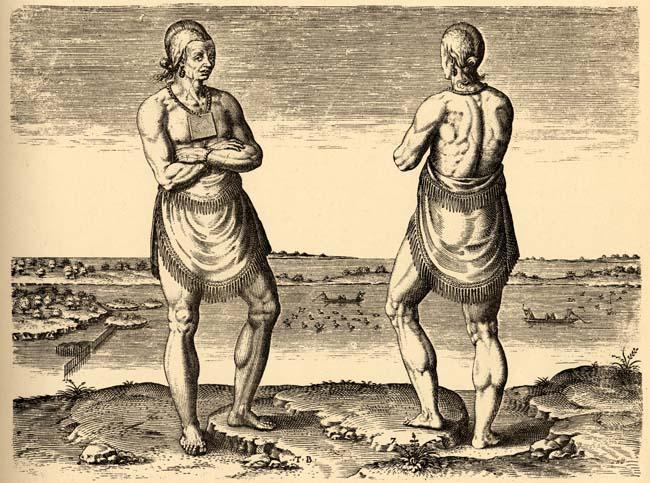A Chief Lorde of Roanoac
"A Cheiff Lorde of Roanoac." Theodor de Bry's engraving of an American Indian man, published in Thomas Hariot's 1588 book A Briefe and True Report of the New Found Land of Virginia. In the foreground, the man is depicted from both the front and back, standing with his arms crossed. He is wearing a fringed garment and a necklace with a large ornament. In the background is a body of water in which people are rowing canoes. A fishing weir can be seen in the background on the left side of the image. The text accompanying the image reads: "The chief men of the island and town of Roanoke reace the hair of their crowns of their heads cut like a cock's comb, as the others do. The rest they wear long as women and truss them up in a knot in the nape of their necks. They hang pearls string upon a thread at their ears, and wear bracelets on their arms of pearls, or small beads of copper or of smooth bone called minsal, neither painting nor pouncing [tattooing] of them selves, but in token of authority, and honor, they wear a chain of great pearls, or copper beads or smooth bones about their necks, and a plate of copper hinge upon a string, from the navel unto the middle of their thighs. They cover themselves before and behind as the women do with a deer's skin handsomely dressed, and fringed. More over they fold their arms together as they walk, or as they talk one with another in sign of wisdom. The isle of Roanoke is very pleasant, and has plenty of fish by reason of the Water that environs the same." Theodor de Bry was a Flemish-born engraver and publisher who based his illustrations for Hariot's book on the New World paintings of colonist John White. These depictions of the landscapes and residents of North Carolina provided Europeans with some of their earliest notions of what the North American continent looked like. This engraving was based on White's watercolor painting, "Indian Elder or Chief."
UNC Documenting the South: article on "Thomas Hariot", including more engravings by Theodor de Bry. https://docsouth.unc.edu/nc/hariot/hariot.html

de Bry, Theodore. A Chieff Lorde of Roanac. Print: Engraving. 1590. British Library. https://www.bl.uk/collection-items/engravings-of-native-americans-and-pi... (Accessed October 31, 2018)
Public Domain
Public Domain is a copyright term that is often used when talking about copyright for creative works. Under U.S. copyright law, individual items that are in the public domain are items that are no longer protected by copyright law. This means that you do not need to request permission to re-use, re-publish or even change a copy of the item. Items enter the public domain under U.S. copyright law for a number of reasons: the original copyright may have expired; the item was created by the U.S. Federal Government or other governmental entity that views the things it creates as in the public domain; the work was never protected by copyright for some other reason related to how it was produced (for example, it was a speech that wasn't written down or recorded); or the work doesn't have enough originality to make it eligible for copyright protection.
Add a comment
PLEASE NOTE: NCpedia provides the comments feature as a way for viewers to engage with the resources. Comments are not published until reviewed by NCpedia editors at the State Library of NC, and the editors reserve the right to not publish any comment submitted that is considered inappropriate for this resource. NCpedia will not publish personal contact information in comments, questions, or responses. If you would like a reply by email, note that some email servers, such as public school accounts, are blocked from accepting messages from outside email servers or domains. If you prefer not to leave an email address, check back at your NCpedia comment for a reply. Please allow one business day for replies from NCpedia. Complete guidelines are available at https://ncpedia.org/about.